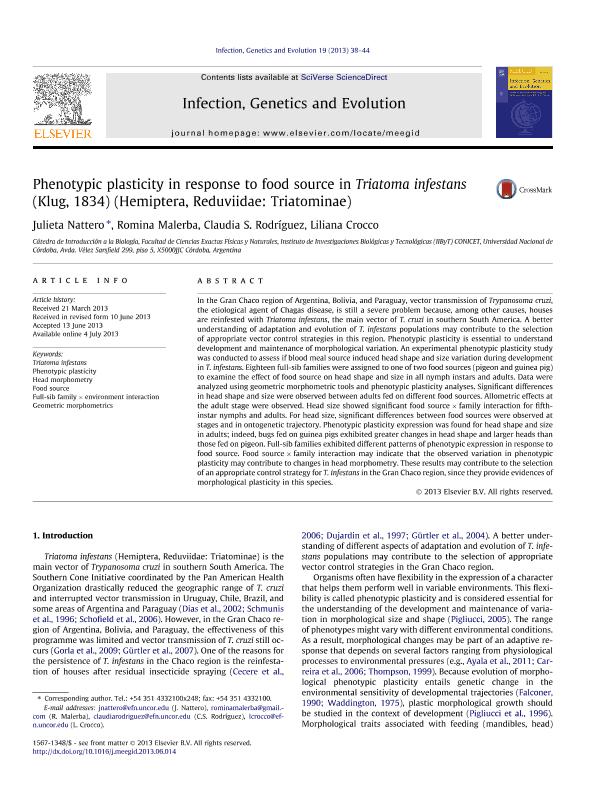Artículo
Phenotypic plasticity in response to food source in Triatoma infestans (Klug, 1834) (Hemiptera, Reduviidae: Triatominae)
Fecha de publicación:
07/2013
Editorial:
Elsevier Science
Revista:
Infection, Genetics and Evolution
ISSN:
1567-1348
Idioma:
Inglés
Tipo de recurso:
Artículo publicado
Clasificación temática:
Resumen
In the Gran Chaco region of Argentina, Bolivia, and Paraguay, vector transmission of Trypanosoma cruzi, the etiological agent of Chagas disease, is still a severe problem because, among other causes, houses are reinfested with Triatoma infestans, the main vector of T. cruzi in southern South America. A better understanding of adaptation and evolution of T. infestans populations may contribute to the selection of appropriate vector control strategies in this region. Phenotypic plasticity is essential to understand development and maintenance of morphological variation. An experimental phenotypic plasticity study was conducted to assess if blood meal source induced head shape and size variation during development in T. infestans. Eighteen full-sib families were assigned to one of two food sources (pigeon and guinea pig) to examine the effect of food source on head shape and size in all nymph instars and adults. Data were analyzed using geometric morphometric tools and phenotypic plasticity analyses. Significant differences in head shape and size were observed between adults fed on different food sources. Allometric effects at the adult stage were observed. Head size showed significant food source × family interaction for fifth-instar nymphs and adults. For head size, significant differences between food sources were observed at stages and in ontogenetic trajectory. Phenotypic plasticity expression was found for head shape and size in adults; indeed, bugs fed on guinea pigs exhibited greater changes in head shape and larger heads than those fed on pigeon. Full-sib families exhibited different patterns of phenotypic expression in response to food source. Food source × family interaction may indicate that the observed variation in phenotypic plasticity may contribute to changes in head morphometry. These results may contribute to the selection of an appropriate control strategy for T. infestans in the Gran Chaco region, since they provide evidences of morphological plasticity in this species.
Palabras clave:
Triatoma Infestans
,
Phenotipic Plasticity
,
Head Morphometry
,
Food Source
Archivos asociados
Licencia
Identificadores
Colecciones
Articulos(IIBYT)
Articulos de INSTITUTO DE INVESTIGACIONES BIOLOGICAS Y TECNOLOGICAS
Articulos de INSTITUTO DE INVESTIGACIONES BIOLOGICAS Y TECNOLOGICAS
Citación
Nattero, Julieta; Malerba, Romina Celeste; Rodriguez, Claudia Susana; Crocco, Liliana Beatriz; Phenotypic plasticity in response to food source in Triatoma infestans (Klug, 1834) (Hemiptera, Reduviidae: Triatominae); Elsevier Science; Infection, Genetics and Evolution; 19; 7-2013; 38-44
Compartir
Altmétricas




